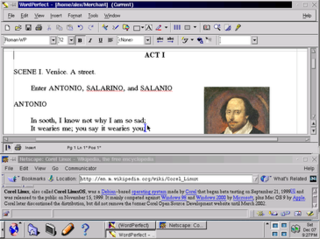Slashdot is a social news website that originally billed itself as "News for Nerds. Stuff that Matters". It features news stories on science, technology, and politics that are submitted and evaluated by site users and editors. Each story has a comments section where users can add online comments.
Windows Media Audio (WMA) is a series of audio codecs and their corresponding audio coding formats developed by Microsoft. It is a proprietary technology that forms part of the Windows Media framework. WMA consists of four distinct codecs. The original WMA codec, known simply as WMA, was conceived as a competitor to the popular MP3 and RealAudio codecs. WMA Pro, a newer and more advanced codec, supports multichannel and high-resolution audio. A lossless codec, WMA Lossless, compresses audio data without loss of audio fidelity. WMA Voice, targeted at voice content, applies compression using a range of low bit rates. Microsoft has also developed a digital container format called Advanced Systems Format to store audio encoded by WMA.

Corel Linux, also called Corel LinuxOS, was a Debian-based operating system made by Corel that began beta testing on September 21, 1999 and was released to the public on November 15, 1999. It mainly competed against Windows 98 and Windows 2000 by Microsoft, plus Mac OS 9 by Apple. Corel later discontinued the distribution, but did not remove the former Corel Open Source Development website until March 2002.

Neptune was the codename for a version of Microsoft Windows under development in 1999. Based on Windows 2000, it was originally to replace the Windows 9x series and was scheduled to be the first home consumer-oriented version of Windows built on Windows NT code. Internally, the project's name was capitalized as NepTune.

Windows Genuine Advantage (WGA) was an anti-infringement system created by Microsoft used to validate the licences of several Microsoft Windows operating systems upon accessing services such as Windows Update and Microsoft Download Center.

Windows Server 2008, codenamed "Longhorn Server", is the seventh release of the Windows Server operating system produced by Microsoft as part of the Windows NT family of the operating systems. It was released to manufacturing on February 4, 2008, and generally to retail on February 27, 2008. Derived from Windows Vista, Windows Server 2008 is the successor of Windows Server 2003 and the predecessor to Windows Server 2008 R2. It removed support for processors without ACPI, and is the first version that includes Hyper-V.
The development of Windows Vista began in May 2001, prior to the release of Microsoft's Windows XP operating system, and continuing until November 2006.

Zune is a defunct brand of digital media products and services that was marketed by Microsoft from November 2006 until it was discontinued in June 2012. Zune consisted of a line of portable media players, a music subscription service known as Zune Music Pass plus Zune Marketplace for music, TV and movies, streaming services for the Xbox 360 game console, and the Zune software media player for Windows PCs which also acted as desktop sync software for Windows Phone.
Windows XP visual styles are customizations of the graphical user interface of Windows XP. "Luna", "Royale", "Zune", and "Embedded" are codenames of the official visual styles designed for Windows XP by Microsoft. Since Windows XP, themes include the choice of visual styles as well. By default, "Luna" is preinstalled on Windows XP Home and Professional editions, "Royale" is preinstalled on Windows XP Media Center Edition and "Embedded" is preinstalled on Windows Embedded Standard 2009 and Windows Embedded POSReady 2009. In addition to the preinstalled visual styles, Microsoft has released additional ones for download. There were also some placeholder visual styles that Microsoft had used in beta versions of Windows before unveiling the official visual styles, such as "Watercolor" and "Mallard". Third parties have also released visual styles, though these require modification of core Windows components to work. Visual styles are compatible with all Windows XP editions except Starter Edition.
Development of Windows XP started in 1999 as a successor to the Windows Neptune and Windows Odyssey projects. Neptune was originally going to be the successor of Windows Me, though based on the NT kernel. Microsoft merged the teams working on Neptune with that of Windows Odyssey, Windows 2000's successor, in early 2000. The resulting project, codenamed "Whistler", went on to become Windows XP.
MinWin is a term used informally by Microsoft to describe the kernel and operating system components that form the basis of releases of Microsoft Windows starting with Windows Vista. The term was first used in 2003 to describe approximately 95% of the common components of the operating system, but has over time come to refer to a significantly smaller portion. Its most recent and most well-known variation was a minimalistic, self-contained set of Windows components that shipped as part of Windows 7 and Windows Server 2008 R2.

Internet Explorer 9 or IE9 is the ninth major version of the Internet Explorer web browser for Windows. It was released by Microsoft on March 14, 2011, as the successor to Internet Explorer 8. Microsoft released Internet Explorer 9 as a major out-of-band version that was not tied to the release schedule of any particular version of Windows, unlike previous versions. It is the first version of Internet Explorer not to be bundled with a Windows operating system, although some OEMs have installed it with Windows on their PCs. Internet Explorer 9 was the last version to be called Windows Internet Explorer. The software was rebranded simply as Internet Explorer starting with the release of Internet Explorer 10.

The Zune HD is a portable media player in the Zune product family released on September 15, 2009, by Microsoft. It was a direct competitor with Apple's iPod Touch series of mobile devices. It was initially released in 16 and 32 GB capacities. A 64 GB version was released on April 9, 2010. It has a touchscreen interface for navigation and included Wi-Fi for synchronization, access to the Zune Marketplace and Web browsing.

Kin was a short-lived mobile phone line from Microsoft designed for users of social networking. The phones, aimed at people between ages 15 and 30, were manufactured by Sharp Corporation and sold through Verizon Wireless.

Windows Mobile 6.5 is a version of Windows Mobile. It was a stopgap update to Windows Mobile 6.1 intended to bridge the gap between version 6.1, that arrived in 2008, and Windows Phone 7 that was released in 2010.
The leap year problem is a problem for both digital (computer-related) and non-digital documentation and data storage situations which results from errors in the calculation of which years are leap years, or from manipulating dates without regard to the difference between leap years and common years.

Mary Jo Foley is an American freelance technology writer, author, podcaster and news editor. She regularly writes news, previews, and reviews for Microsoft's strategy, products and technology. Foley has been covering news on Microsoft Windows, and previously on Unix-related technology, since 1983, for publications including ZDNet, eWeek, Baseline, Redmond magazine,PC Magazine, and Directions on Microsoft.
The Microsoft .NET strategy is a marketing plan that Microsoft followed in the early 2000s. Steve Ballmer described it as the company's "most ambitious undertaking since Internet Strategy Day in 1995". In support of this strategy, between 2000 and 2002, Microsoft released ".NET" branded updates to its works, including Visual Studio .NET, Visual Basic .NET, .NET Passport, .NET My Services, .NET Framework, ASP.NET and ADO.NET. A Windows .NET Server was also announced. Microsoft had plans to include Microsoft SQL Server, Microsoft Exchange Server and MSN into this strategy.








